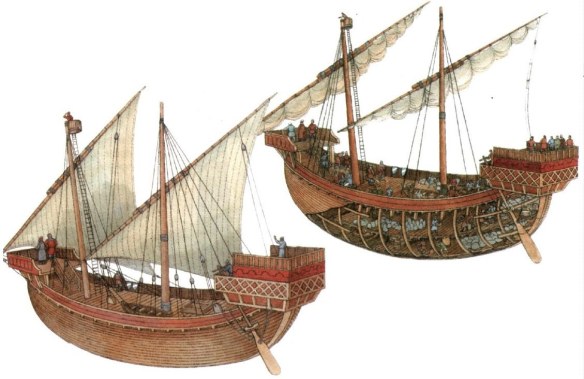Round Ship
Northern Europeans owed their maritime dominance over their southern neighbors, and ultimately over the entire world, to a pair of interrelated developments. First, northerners quickly adopted, by necessity rather than choice, improved roundships as war platforms; the Mediterranean states, both Christian and Muslim, did not. Second, the northern Europeans’ continued refinement of the sailing man-of-war in the fourteenth and fifteenth centuries positioned them, unlike their southern neighbors, to take full advantage of the development of cheap iron cannon late in the sixteenth century.
Since the galley was never as satisfactory a platform for ship-to-ship fighting in rough northern waters as in the Mediterranean, as shipwrights constructed larger, more strongly built, more maneuverable roundships in the thirteenth century, states fronting the Atlantic began to incorporate the new vessels into their naval forces. The late-twelfth-century English navy, for example, consisted principally of assorted types of galleys, but by the early thirteenth century powerful roundships formed the core of English battlefleets. By the early fourteenth century galleys had all but disappeared from English orders of battle. In contrast, well into the sixteenth century Mediterranean navies clung to their battle proven galleys, which continued to hold their own against roundships.
As a result, northern shipbuilders had a three-century head start, not in the design and development of sailing ships as such, but in the refinement of the roundship as a fighting platform. While most sailing ships taken into the fleet in wartime were merchant vessels pressed temporarily into service, northern European states began to look to shipwrights to design and build sailing vessels specifically for wartime use. These new ships incorporated several prominent design features, such as towering fore and aft “castles,” or fighting platforms, from which soldiers could hurl projectiles down onto their enemies. Gradually, the recognizable design of purpose-built sailing warships began to emerge.
Nevertheless, these early sailing men-of-war, even when armed with the primitive gunpowder weapons of the day, did not yet ensure technological superiority for northern navies beyond their home waters. Until the sixteenth century reliable cannon were too expensive to be used extensively, whether on land or on sea. States generally consigned their heavy guns to siege trains, of which the Muslim Ottomans, not the Christian Europeans, had the most powerful. Navies, both northern and Mediterranean, mounted only small numbers of heavy cannon, mostly brass or bronze, in the bows of their ships.
The costliness of the great guns masked the true nature of the technological changes taking place in the maritime world and lulled the Mediterranean powers into unwarranted complacency. As long as fiscal concerns limited the naval use of artillery, the galley was a viable fighting platform. Since bow-mounted guns fired forward, in battle they could be used more efficiently by the highly maneuverable galleys than by sailing ships. Thus in 1500 no one recognized that the war galley had reached the end of its long history of development; no one foresaw that the fighting roundship would continue to evolve as a weapons system for another 350 years; no one knew that by the end of the century the advent of cheap iron cannon would allow the larger, longer-ranged roundship to carry powerful broadside batteries to the four corners of the globe; no one suspected that the age of galley warfare was drawing to a close
